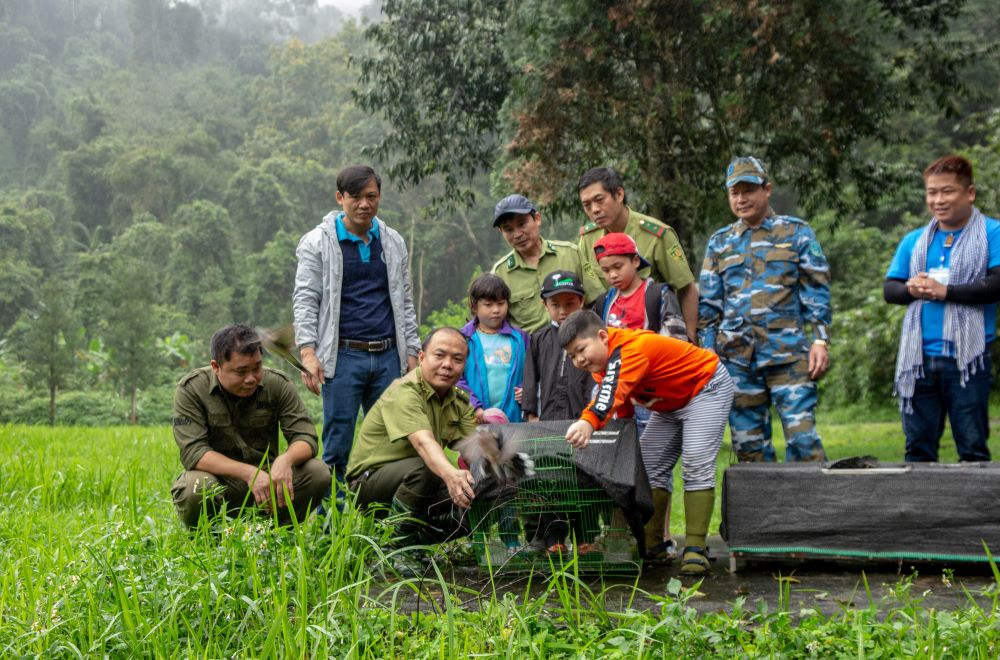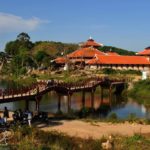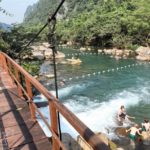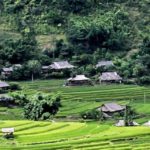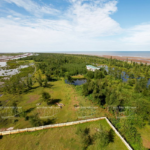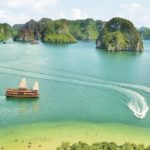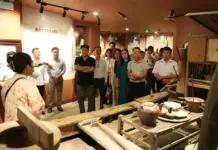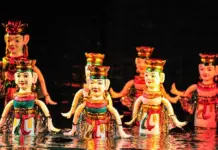Cuc Phuong National Park, the first of its kind in Vietnam, celebrated the 60th anniversary of its establishment today [December 2], one of the most important sites for biodiversity and eco-tourism in the 42% forested Southeast Asian country.
Vietnam’s oldest national park with more than 22,000ha has inspired the world with the values of nature, of an intact jungle, and conveyed a message of animal rescue and forest stewardship.
| Nguyen Minh Chinh (3rd left), Director of Cuc Phuong National Park, in the release of animals at the park. Photo: Bao Ninh Binh |
Nguyen Minh Chinh, Director of Cuc Phuong National Park, said Cuc Phuong had been the prototype of the establishment of 33 other national parks nationwide since its establishment in 1962.
He said the success story of preservation in Cuc Phuong is contributed by three main factors, namely the early recognition of the forest’s role by Vietnamese leadership in environmental protection, the international support, and the characteristics of local ethnic minority people.
For that reason, the park has its own direction by putting conservancy first and foremost to make Cuc Phuong undeniably different from other models of its kind, Nguyen Minh Chinh told The Hanoi Times.
Accordingly, the question is whether it will be worth the effort or whether they will really be able to make a difference amid financial woes.
“We have struggled to maintain the initial policy to ensure that the management would promote efforts tirelessly made by generations of people over the past six decades,” the director noted.
He made the affirmation in the context that Cuc Phuong in different periods of time faced the dilemma of whether or not to catch up with the trend of tourism.
“Above all, we all acknowledge that nothing could be worth trading the values of nature for economic benefits,” Chinh shared with The Hanoi Times with an emotional expression.
That thought has sustained people who are involved in the joint mission throughout the years.
| Nguyen Manh Cuong, Head of Cuc Phuong National Park’s Department of Foreign Relations. Photo: Bao Ninh Binh |
Joint dedication
Echoing Chinh, Nguyen Manh Cuong, Head of the national park’s Department of Foreign Relations, highlighted the contributions of people who are dedicated to meaningful undertakings regardless of social status, country of birth, or age.
Different preservation programs have reflected the common drive that marks the engagement of communities and individuals domestically and internationally, Cuong said, taking some typical examples dating from the late 1980s.
So far, there have been nine cooperation projects, including Assistance to strengthen Cuc Phuong National Park; Enhancing wildlife conservation; Promoting biodiversity conservation and sustainable livelihoods; Endangered Primate Rescue Center; Cuc Phuong Conservation Project, among others.
Notably, the Turtle Conservation Center in Cuc Phuong is a world-renown rescue center for tortoises and freshwater turtles to conserve the creatures that have been on earth for over 150 million years.
In addition, the Endangered Primate Rescue Center there has rescued and reproduced hundreds of endangered primates in Vietnam. After Cuc Phuong National Park, the Frankfurt Zoological Society (FZS) has supported other national parks and nature reserves of Vietnam to protect their rare species and forest habitats such as Van Long Nature Reserve, Cat Ba National Park, Phong Nha – Ke Bang National Park, and Kon Ka Kinh National Park.
The conservation efforts have been contributed by the United Nations specialized agency of Food and Agriculture Organization (FAO), Fauna and Flora International (FFI) – the world’s longest-established international conservation body; the Frankfurt Zoological Society (FZS), the US Agency for International Development (USAID); the University of Illinois at Chicago, the US; the Indo-Myanmar Conservation; and the Waterloo Foundation.
To serve sustainable development, international support has been spent on building the livelihoods of residents who are mostly Muong ethnic minority, Nguyen Manh Cuong talked with The Hanoi Times.
The combination of conservation and nature-based tourism has enabled Cuc Phuong to keep up the long-lasting achievements while promoting cultural and tourism models and educating responsibilities of nature protection among people, especially youth.
Innovative community-based tourism solutions demonstrate the fruitful partnership between Vietnam and international forces and once again affirm the right track that Cuc Phuong has followed despite ups and downs, Cuong emphasized.
The cooperative cause has named Cuc Phuong a candidate site for the International Union for Conservation of Nature (IUCN) Green List.
Decades-long typical model
The conservation of Cuc Phuong National Park was reiterated today in celebration of the 60th anniversary of its establishment.
In an opening remark at the ceremony, Nguyen Quoc Tri, Deputy Minister of Agriculture and Rural Development, said Cuc Phuong leads the natural reserves in Vietnam in terms of research for the conservation of rare and endemic species, training manpower for the country’s forestry sector, and typical choice for the world’s scientists and conservationists.
On this occasion, he stressed the importance of forest protection, which should be equipped with the application of technologies in forest patrol and supervision of biodiversity.
Addressing the event, Cuc Phuong National Park’s Director Nguyen Minh Chinh highlighted the conservation ecosystem initiated in the park. The model has synchronized activities and products of environmental education with its own identity, towards the goal of sustainable development.
The old forest is home to more than 2234 vascular and non-vascular plants, 122 species of reptiles and amphibians, and 135 species of mammals, including the Asian Black Bear, Clouded Leopard, Delacour’s Langur, and Owston’s Civet. An astounding 336 bird species have been identified coupled with nearly 400 species of butterflies.
In a broader sense, the establishment of the country’s first protected area at Cuc Phuong National Park in 1962 has resulted in the system of Special-use Forests, which now consists of 152 sites covering 7.2% of Vietnam’s natural area.
According to the IUCN, Currently, Vietnam has 9 Ramsar sites, all of which are designated Special Use Forests (SUFs); 9 Biosphere reserves; 5 ASEAN Heritage parks (all SUFs); 2 World Natural Heritage sites, and 1 World Mixed Heritage site.
Cam Mountain
Cam Mountain known as Thien Cam Son is considered a beautiful silk brocade. It is the highest and most grandiose mountain in the That Son area in the triangle of Tinh Bien-Nha Bang-Tri Ton in An Hao Commune, Tinh Bien District of An Giang Province. The landscape in this area charms like a painting that fascinates every visitor.
Enhancing Operational Efficiency at Vietnam’s World Heritage Sites
NDO—Nhan Dan recently published a Vietnamese-language story calling for an immediate end to the organisation of parties in the caverns at Ha Long Bay, which revealed typical shortcomings in the management of World Heritage Sites in Vietnam. But we must look no further than some limitations of the current management model to uncover the main cause of such confusion.

